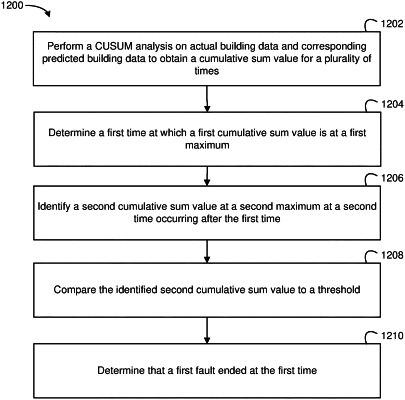| CPC F24F 11/38 (2018.01) [F24F 11/49 (2018.01); G06F 17/18 (2013.01); H04L 67/12 (2013.01); F24F 2120/20 (2018.01)] | 20 Claims |

|
1. A building system for detecting faults in an operation of building equipment, the building system comprising one or more non-transitory memory devices configured to store instructions thereon that, when executed by one or more processors, cause the one or more processors to:
receive actual building data from a plurality of sensors;
generate a model indicating corresponding predicted building data;
perform a cumulative sum (CUSUM) analysis on the actual building data and the corresponding predicted building data to obtain cumulative sum values for a first plurality of times within a first time period, wherein the cumulative sum values are cumulative error values determined based on the actual building data and the corresponding predicted building data;
determine a first time at which a first cumulative sum value reaches a threshold;
analyze cumulative sum values associated with a second plurality of times occurring before the first time to identify a second time of the second plurality of times at which a second cumulative sum value is at a local minimum, wherein the local minimum is lower than the next and the previous cumulative sum value, wherein analyzing the cumulative sum values comprises stepping backward in time from the first time and, with each step backward in time, comparing a corresponding cumulative sum value with a previously analyzed cumulative sum value until reaching a time at which the corresponding cumulative sum value either increases or does not change relative to the previously analyzed cumulative sum value;
determine that a first fault began at the second time; and
at least one of:
(i) execute a control or maintenance activity based on the first fault, the control or maintenance activity comprising at least one of repairing the first fault or working-around the first fault, shutting-down one or more devices or systems in response to the first fault, or directing control activities around the one or more devices or systems in response to the first fault, or
(ii) generate an alert in a user interface indicating the first fault began at the second time.
|